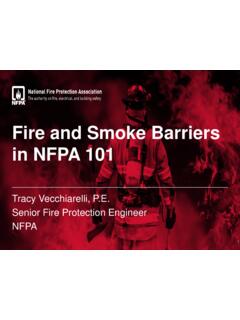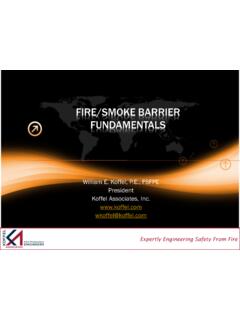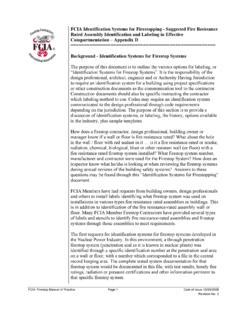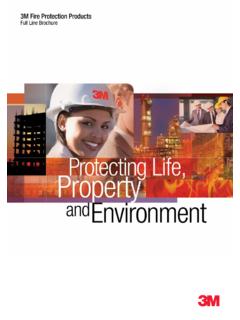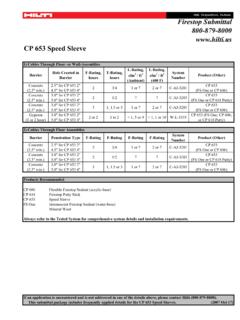Transcription of Through-penetration Firestop Systems - FCIA
1 Home Quick Guide Contact Us Through-penetration Firestop Systems View Listings Page Bottom Through-penetration Firestop Systems Guide Information for Fire Resistance Ratings GENERAL This category covers Firestop Systems , which are specific constructions consisting of a wall or floor assembly, a penetrating item passing through an opening in the wall or floor assembly, and the materials designed to prevent the spread of fire through the openings. The specifications for materials in a Firestop system and the assembly of the materials are details that directly relate to the established ratings. Information concerning these details is described in the individual Systems . The hourly ratings apply only to the complete Systems . Individual components are designated for use in a specific system to achieve specified ratings.
2 The individual components are not assigned ratings and are not intended to be interchanged between Systems . Additionally, the substitution or elimination of components required in a system should not be made unless specifically permitted in the individual system or in these general guidelines. The Firestop Systems covered under this category have been investigated with a positive furnace pressure differential of at least in. of water maintained at a distance of 12 in. below horizontal test assemblies and in. below the fill materials surrounding the penetrating items passing through vertical test assemblies. The Classifications of Firestop Systems contemplate installation in heated and air conditioned environments unless stated otherwise in the description of the system .
3 ANSI/UL 1479, "Fire Tests of Through-penetration Firestops," defines the criteria for hourly F, T, L and W ratings for Firestop Systems . The F-rating criteria prohibits flame passage through the system and requires acceptable hose-stream test performance. The T-rating criteria prohibits flame passage through the system and requires the maximum temperature rise on the unexposed surface of the wall or floor assembly, on the penetrating item and on the fill material not to exceed 325 F (181 C) above ambient, and requires acceptable hose-stream test performance. The L-rating criteria determines the amount of air leakage, in cu feet per minute per square foot of opening (CFM/sq ft) or in cu feet per minute per unit (CFM/unit) for fixed-size opening units, through the Firestop system at ambient and/or 400 F air temperatures at an air-pressure differential of in.
4 The L ratings are intended to assist Authorities Having Jurisdiction and others in determining the suitability of Firestop Systems for the protection of penetrations and miscellaneous openings in floors and smoke barriers for the purpose of restricting the movement of smoke in accordance with ANSI/NFPA 101, "Life Safety Code." The Class 1 W rating determines the capability of the Firestop system to maintain watertightness of the penetration through a floor or wall construction at ambient air conditions under 3 ft of water pressure head ( psi) for a period of 72 hours. The W rating may be applicable for building structures whose floors are subjected to incidental standing water and/or for buildings that house critical equipment as described in ANSI/NFPA 75, "Fire Protection of Information Technology Equipment," and ANSI/NFPA 76, "Fire Protection of Telecommunications Facilities.
5 " Acceptance is based upon the ability of the Firestop system to withstand the applied pressure without the passage of any water through the Firestop system . After the Class 1 watertightness test, the Firestop system is conditioned in accordance with the requirements of ANSI/UL 1479 and the fire and hose stream tests described in the standard are conducted. The W rating is intended to assist Authorities Having Jurisdiction and others in determining the suitability of Firestop Systems in applications where submersion in water may be a factor. Materials used in the Firestop Systems are intended to be installed in accordance with the manufacturer's instructions provided with the materials. The structural integrity of the floor or wall assembly needs to be investigated when providing openings for the penetrating items.
6 The fill, void or cavity material thickness published in the fire-resistance designs is measured wet and may be susceptible to a percentage of shrinkage during the curing process. Firestop Systems are investigated after the fill, void or cavity materials are fully cured. Refer to the individual Classifications under Fill, Void or Cavity Materials (XHHW) for the investigated percentage of shrinkage. The minimum and/or maximum annular space referenced in the Firestop system must be maintained in order to achieve the hourly rating of the system . The annular space of a penetrating item through a rectangular opening is determined by measuring the distance from the closest point of the penetrating item to a point perpendicular to each of the four sides of the opening.
7 The diagonal dimension is not intended to represent the annular space of a rectangular opening. The annular space between multiple penetrating items within a rectangular opening is determined by measuring the closest point of one penetrating item to the closest point of the adjacent penetrating item. ANSI/NFPA 90A, "Installation of Air-Conditioning and Ventilating Systems ," contains requirements on the use of fire dampers in conjunction with ventilation ducts. Unless specifically indicated as part of the Classification of the damper, the annular space around the damper sleeve should not be firestopped with the materials described herein. The Systems covered under this category are Classified with respect to (1) installation in a wall only, (2) installation in a floor only or (3) installation in either a wall or a floor.
8 Unless otherwise indicated in the Systems , the ratings for Firestop Systems installed in walls apply when either face of the wall is exposed to fire. The ratings for Firestop Systems installed in a floor apply when the underside or ceiling surface is exposed to fire. The hourly fire-endurance rating of the walls and floors incorporating these Systems are not indicated. Volume 1 of the Fire Resistance Directory covers the hourly fire-endurance ratings of floor and wall assemblies. Firestop Systems that specify installation in concrete floors may include installation in floors consisting of fluted or corrugated steel deck topped with structural concrete, provided that (1) the concrete topping thickness measured above the top plane of the steel deck is equal to our greater than the minimum concrete thickness specified in the system , and (2) the Firestop system does not require any portion of the forming material or fill material to extend below the bottom plane of the floor.
9 Some Firestop Systems specify the use of hollow-core precast concrete unit floor assemblies. Where not specified, Firestop Systems utilizing caulk, sealant, putty or spray materials installed over a mineral wool or ceramic blanket may be installed in hollow-core floors, provided that (1) the thickness of the hollow-core floor is equal to or greater than the minimum concrete thickness specified in the system , (2) the maximum size of the opening is 7 in. diameter or 7 in. by 7 in., and (3) any cores of the precast concrete units penetrated as a result of the Firestop system are sealed with a minimum 4 in. depth of either firmly packed minimum 4 pcf mineral wool or ceramic fiber blanket, or concrete, grout or mortar. Additionally, Firestop Systems utilizing a Firestop device or wrap strips/steel collar installed around the penetrant beneath the floor may be installed in hollow-core floors, provided that (1) the thickness of the hollow-core floor is equal to or greater than the minimum concrete thickness specified in the system , and (2) the maximum size of the opening is 7 in.
10 Diameter or 7 in. by 7 in. ANSI/NFPA 70, "National Electrical Code" (NEC), contains requirements for permissible installation and percentages of electrical conductor fill for conduit, cable trays and other electrical conductor raceways. Authorities Having Jurisdiction should be consulted as to the particular requirements covering the installation and use of these Classified Systems . PENETRATING ITEMS When the penetrating item is indicated as being conduit, the conduit is intended for use as a raceway for electrical conductors in accordance with the NEC. Electrical conductors may be used without conduit only when permitted by and installed in accordance with the NEC, and when the conductors are specifically described in the Firestop system . The maximum conductor size and the maximum number of conductors in the individual cables are specified in each system .


